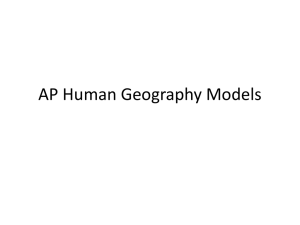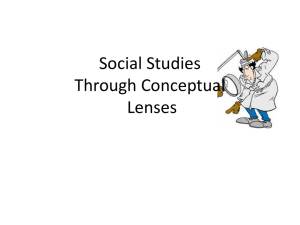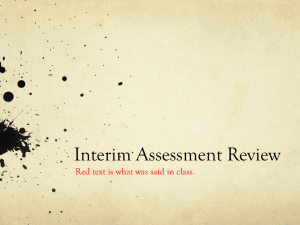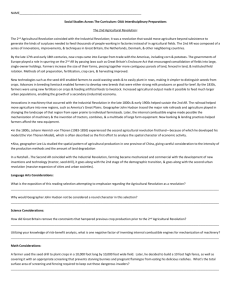AP Human Geography Models
advertisement
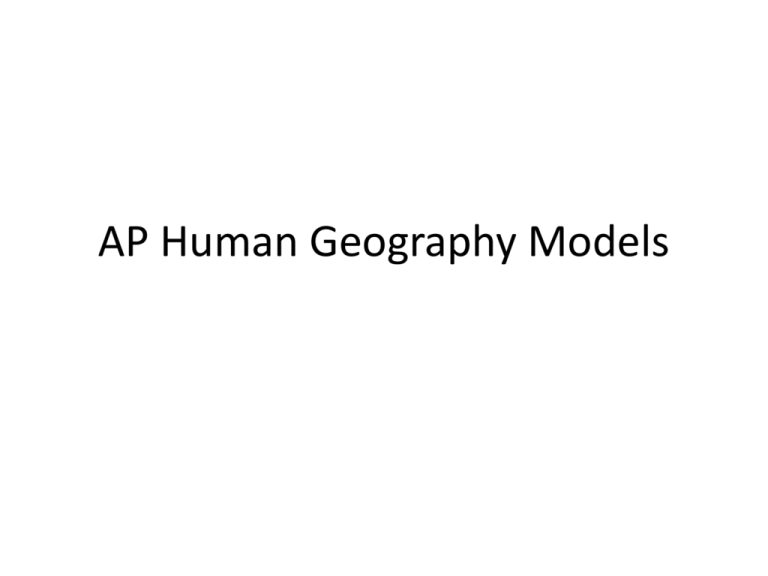
AP Human Geography Models Demographic Transition Model • Geographer: Warren Thompson • Main Ideas: The process of change in a society’s population. • Visual: • Real Life Example: Denmark is in stage 4 of the DTM Gravity Model • Geographer: Based off of Newton’s Laws • Main Ideas: The movement of people, information, and commodities between two places can be predicted • Visual: • Real Life Example: New York and London have a large “attraction” Rostow’s Stages of Growth • Geographer: W.W. Rostow • Main Ideas: As a country develops it moves through a series of stages. • Visual: • Ex: U.S.= Stage 5 Concentric Zone Model • Geographer: E.W. Burgess • Main Ideas: A city grows outward in a series of rings • Visual: • Real Life Example: • Chicago Hoyt Sector Model • Geographer: Homer Hoyt • Main Ideas: A city develops in a series of sectors • Visual: • Real Life Example: Charlotte, NC Multiple Nuclei Model • Geographer: Harris &Ullman • Main Ideas: A city is a complex structure that includes more than one center or node. • Visual: • Real Life Example: Los Angeles Central Place Theory • Geographer: Walter Christaller • Main Ideas: Services are distributed in a regular pattern around settlements that serve as market centers. • Visual: • Real Life Example: • Chic-fil-A locations around Charlotte Model of Industrial Location • Geographer: Alfred Weber • Main Ideas: Predicts where industries will locate based on the least cost to them. • Visual: • Real Life Example: Soda bottling is near the market to save money on transportation costs. Agricultural Model • Geographer: J.H. Von Thunen • Main Ideas: A pattern of 4 rings of agricultural activity would develop around a city. • Visual: • Real Life Example: Intensive agricultural activities are located closer to the city. Epidemiological Transition Model • Geographer: Abdel Omran (not important) • Main Ideas: There is a pattern of the causes of death as your move through the DTM • Visual: • Real Life Example: Cholera is a big killer is stage 2 World Systems Theory • Geographer: Immanuel Wallerstein • Main Ideas: Describes the spatial distribution of world development • Visual: • Real Life Example: • Core: MDCs • Semi-Periphery: Asian Dragons, India, China • Periphery: LDCs Domino Theory • Geographer: Promoted by the U.S. Gov (Eisenhower first to use) • Main Ideas: If one country falls to communism, the others around it would too • Visual: • Real Life Example: • U.S. used this idea to help justify involvement in the Vietnam war Heartland &Rimland Theories • Geographer: Mackinder (H) &Spykman (R) • Main Ideas: H~ Control over land would be the key to power, specifically E. Europe/ Eurasia. R~ whoever was in control of the periphery of Eurasia would be able to dominate the world • Visual: • Real Life Example: H~ Communists wanted to dominate E. Europe & the U.S. Wanted to contain them R~ Vietnam & Korean Wars Were fought over control of rimland areas Malthusian & Neo-Malthusian • Geographer: Thomas Malthus • Main Ideas: The population would eventually become too big to be sustained by the world’s food supply/ resources • Visual: • Real Life Example: Neo-Malthusians like Paul Ehrlich are concerned about current carrying capacity. Bid-Rent Theory • Geographer: n/a • Main Ideas: As the distance from the CBD increases in the concentric zone model, the price of land decreases. • Visual: • Real Life Example: A factory would not locate in the CBD Rank-size Rule • Geographer: n/a • Main Ideas: Acountry’s x largest settlement is 1/x of the population of the largest settlement. • Visual: • Real Life Example: • U.S.– NYC, LA, Chicago, etc. Hearths: Agricultural & Religious • Main Ideas: Buddhism & Hinduism= S. Asia, Christianity & Islam= SW Asia. Vegetative Planting= SE Asia Seed Agriculture= W. India, N. China, Ethiopia, SW Asia, S. Mexico, N. Peru • Visual: • Real Life Example: The hearth of wheat and Barley is SW Asia Ravenstein’s Laws of Migration • Geographer: Ernest Ravenstein • Main Ideas: In the 19th century, Ravenstein wrote laws to help geographers study migration based on the reasons why people move, the distance they move, and their characteristics. • Visual: • Real Life Example: The majority of migrants travel a short distance Renfrew’s Theory of Language Diffusion • Geographer: Colin Renfrew • Main Ideas: The diffusion of the Indo-European language family came from Anatolia, which is where modern day Turkey is now located. From there, the language family diffused into Europe and South Asia with the spread of new agricultural technology from the 1st agricultural revolution. • Visual: • Real Life Example: The Indo-European language has diffused to 48 countries. Agricultural Revolutions: • First Agricultural Revolution/Neolithic Revolution - The domestication of plants and animals around 12,000 BC Second Agricultural Revolution -improved methods of cultivation, harvesting, and storage of farm produce stemming from the Industrial Revolution Third Agricultural Revolution/ Green Revolution- international effort that was planned to eliminate hunger by improving crop performance. Development of genetically engineered crops (GE) or genetically modified organisms (GMOs) It began in the 1960s when a combination of technologies was made available to Mexico and countries in Asia in an effort to improve the diets of people in those regions.
